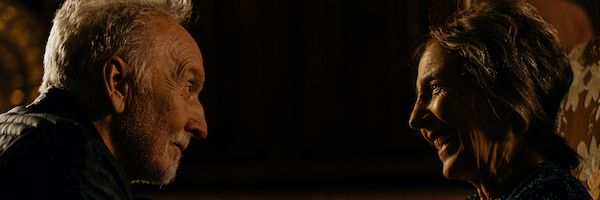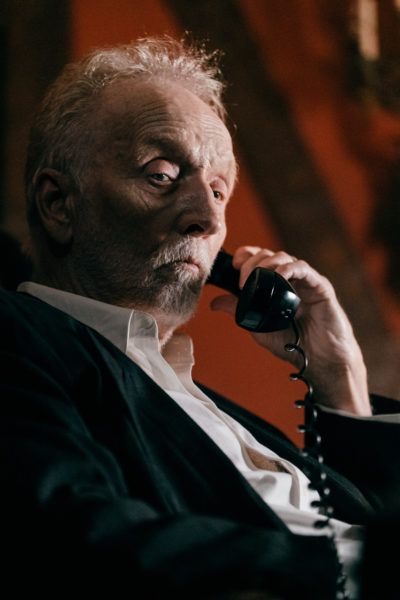In The Call, two titans of James Wan-shepherded horror — Tobin Bell (Saw) and Lin Shaye (Insidious)— come together to torture the hell out of some teenagers. Together, they are the Cranstons, a married couple with a bit of a local reputation of being creepy (and in the case of Shaye, literally a witch). When a group of teens, including our more sensitive newbie hero Chester Rushing, prank the Cranstons aggressively, the Cranstons suffer a tragic fate. And to get their revenge, they make these teens spend just one minute on the phone. On the other end? A litany of supernatural horrors, revelations of traumas, and spooky bloody ghosts, of course.
I spoke with Bell over the phone (naturally) about The Call, an incredible scene that made him have to do it, the joys of working with Shaye, the strategies involved in working on a low-budget set without a ton of time, and the ways he keeps his craft sharp. Plus: The man who gave the Saw franchise its central killer told me why he took the first film in the first place, and hinted at how excited we should all be for the upcoming Spiral: From the Book of Saw.
Collider: What initially attracted you to the role of Edward Cranston?
TOBIN BELL: The long scene in the house, with the four young people. Actors choose jobs for a variety of reasons. I've done a lot of films and a lot of TV, and sometimes I get an offer on something and I go, "Oh wow, man, that's in the Mississippi Delta. Geez, I've never been there. I really would love to see where the blues was born and get down there in that Civil War country and see some of the South." Or, you know, it might be the money. Or it might be — I did Saw I, for example, because Danny Glover was in it. And I had never worked with Danny Glover and I had a lot of respect for Danny, and he had had a great career. And so people do things for different reasons.
And I did The Call because I read that scene, that long scene with the four kids in the house, and that scene struck me as a wonderful exercise, a challenge to make that scene flow. There was a lot of dialogue. Edward Cranston, the character I play, had a lot of dialogue in that scene, and to make it not sound like a monologue but to infuse it with physical logic and still have it be tension-filled, was a great challenge. And you do things for different reasons, as I said, and the reason why I did this was because it's like being a blacksmith. You keep your hammer close by, and you keep your knives well sharpened. So I was like, "Wow, yeah. I want to do this scene." And I had never met the director, Timothy Woodward, until actually I got to the set. And Timothy had some really good ideas on how to do it, and we combined our thoughts. And the kids were great. And so that's what attracted me to the material. That scene, specifically.
That scene really stuck out for me as well. And it's curious to hear you say you only met the director when you arrived to set. Was there any time given to an onset rehearsal process? What was the creative process to attack the scene, with you and the director?
BELL: Well, with relatively low budget films, or even medium budget films, you don't have a lot of rehearsal time. Frankly, matter of fact, I've worked with a lot of directors, from Sydney Pollack, to Alan Parker, to Wolfgang Petersen, Martin Scorsese. A lot of actors, and a lot of directors, don't even like to rehearse. In this case, I arrived on the set, and I said, "Timothy, will you show me the room?" And he brought me into the room. And I said, "Where are the chairs going to be? Where's the table going to be?" Because acting is doing. Acting is not about the lines. And there's a physical logic to everything. And so that's basically what we did, was arrange the room. And I would say to him, "How about if we put the envelopes over there? So that while I'm saying this, I could go get [them]." So that's the kind of thing that we did. We did it in a relatively, very short period of time, and then it's time to get dressed and to rehearse. And by rehearse, I mean walk through the scene so that the lighting guys can know where you're going to be and can light the scene. Then you have a brief break in between, and then you go. And that's it. So it was a great challenge, and the kind of thing that all actors like to work at, because it helps you continue to sharpen your craft.
What was your relationship with these four younger performers, these kids like? Did you try and cultivate a sort of offscreen menace, as I've heard some horror actors like to do? Or were you relatively chummy with them?
BELL: [laughter] I was hopefully gentlemanly with them, and kind, and welcoming. Which I think Edward was. I mean, it wasn't as if he was being rude. He wasn't. He was being very specific and very much a businessman. And so that's pretty much what you see on screen. We would chat for a minute about this or that, or they would ask me a question about something, and I would answer it, or try to answer it. I don't engage a lot with other actors on sets anyway. Even on cell phones or anything like that. I tend to stay in, try to develop the sense of the state that my character is in, and how he feels about those people. And, as you noticed, he was quite cordial with them, invited them in, and, "Please sit down," and he was very gentlemanly. Inviting, but all business. And I think I was pretty much that way with the actors themselves.
There is a very deeply kind of emotional and vulnerable scene that you and Lin Shaye have together that just broke my heart. Did the two of you work together on how to craft this lived history between you two?
BELL: No, we didn't. We didn't. We had no time for that. Lin brings a sense of humanity to every role that she plays, even if the character she's playing is a very edgy, living on a frontier-type person. She still develops the human side of that character. And that's the side that I was trying to connect with. I like to connect, as an actor. And it's lovely when you're working with an actress like Lin, who likes to connect also. And there was, for example, a moment where I had to approach her and she was sitting in a chair, and my natural instinct was to kneel in front of her. And so I did. And I honestly think that Edward worshiped her, in some way. So I hope that Edward's caring about Edith is reflected in the film. Because it makes for good contrast with the scares in the film, and with the pretty gruesome moments that exist toward the end of the film.
I'm curious if you were at all involved with, or if you're excited for, Spiral, Chris Rock's take on the Saw mythology.
BELL: Oh yeah. I'm excited for it, but it's not something I can really talk about at this particular moment. But I can tell you, if it's Chris Rock's story, it's likely going to be worth seeing, because he's a very creative guy. And that's about as much as I can say at the moment. Chris is such a talent that I can't imagine that it won't be pretty compelling.
The Call comes to theaters and drive-ins October 2.


